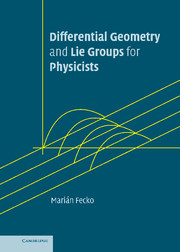Book contents
- Frontmatter
- Contents
- Preface
- Introduction
- 1 The concept of a manifold
- 2 Vector and tensor fields
- 3 Mappings of tensors induced by mappings of manifolds
- 4 Lie derivative
- 5 Exterior algebra
- 6 Differential calculus of forms
- 7 Integral calculus of forms
- 8 Particular cases and applications of Stokes' theorem
- 9 Poincaré lemma and cohomologies
- 10 Lie groups: basic facts
- 11 Differential geometry on Lie groups
- 12 Representations of Lie groups and Lie algebras
- 13 Actions of Lie groups and Lie algebras on manifolds
- 14 Hamiltonian mechanics and symplectic manifolds
- 15 Parallel transport and linear connection on M
- 16 Field theory and the language of forms
- 17 Differential geometry on TM and T *M
- 18 Hamiltonian and Lagrangian equations
- 19 Linear connection and the frame bundle
- 20 Connection on a principal G-bundle
- 21 Gauge theories and connections
- 22 Spinor fields and the Dirac operator
- Appendix A Some relevant algebraic structures
- Appendix B Starring
- Bibliography
- Index of (frequently used) symbols
- Index
10 - Lie groups: basic facts
Published online by Cambridge University Press: 06 July 2010
- Frontmatter
- Contents
- Preface
- Introduction
- 1 The concept of a manifold
- 2 Vector and tensor fields
- 3 Mappings of tensors induced by mappings of manifolds
- 4 Lie derivative
- 5 Exterior algebra
- 6 Differential calculus of forms
- 7 Integral calculus of forms
- 8 Particular cases and applications of Stokes' theorem
- 9 Poincaré lemma and cohomologies
- 10 Lie groups: basic facts
- 11 Differential geometry on Lie groups
- 12 Representations of Lie groups and Lie algebras
- 13 Actions of Lie groups and Lie algebras on manifolds
- 14 Hamiltonian mechanics and symplectic manifolds
- 15 Parallel transport and linear connection on M
- 16 Field theory and the language of forms
- 17 Differential geometry on TM and T *M
- 18 Hamiltonian and Lagrangian equations
- 19 Linear connection and the frame bundle
- 20 Connection on a principal G-bundle
- 21 Gauge theories and connections
- 22 Spinor fields and the Dirac operator
- Appendix A Some relevant algebraic structures
- Appendix B Starring
- Bibliography
- Index of (frequently used) symbols
- Index
Summary
• Groups may be ranked among the most important objects in mathematics and indirectly in theoretical physics as well. This reputation is by no means accidental, but it is related to the fact that they serve as a formal tool for utilizing symmetries; the importance of groups is then simply a reflection of the importance of symmetries.
From the perspective of differential geometry a special class of groups turns out to be of particular interest, namely the Lie groups. They represent objects in which their two distinct aspects peacefully coexist in a happy symbiosis, shoulder to shoulder: algebraic (they are groups) and geometrical or differential-topological (they are smooth manifolds). These two aspects restrict one another, but (as the world goes in a good partnership) they also immensely enrich one another – the richness of the geometry on Lie groups ultimately springs from the existence of the algebraic structure of groups.
Automorphisms of various structures and groups
• Groups occur in all applications by means of their actions, as groups of transformation of something. The transformations of an arbitrary set X (bijective maps g : X → X; for finite sets the permutations) are endowed naturally with the structure of a group (with respect to the composition of maps). A simple, albeit highly important, observation is that if we add some structure on X (being for now only a set), X ↦ (X, s), then the transformations which preserve (respect) the structure, the automorphisms of the structure (X, s), also constitute a group, which is clearly a subgroup of the group of all transformations of the “bare” set X; we will denote this group by G.
- Type
- Chapter
- Information
- Differential Geometry and Lie Groups for Physicists , pp. 204 - 213Publisher: Cambridge University PressPrint publication year: 2006



